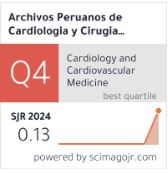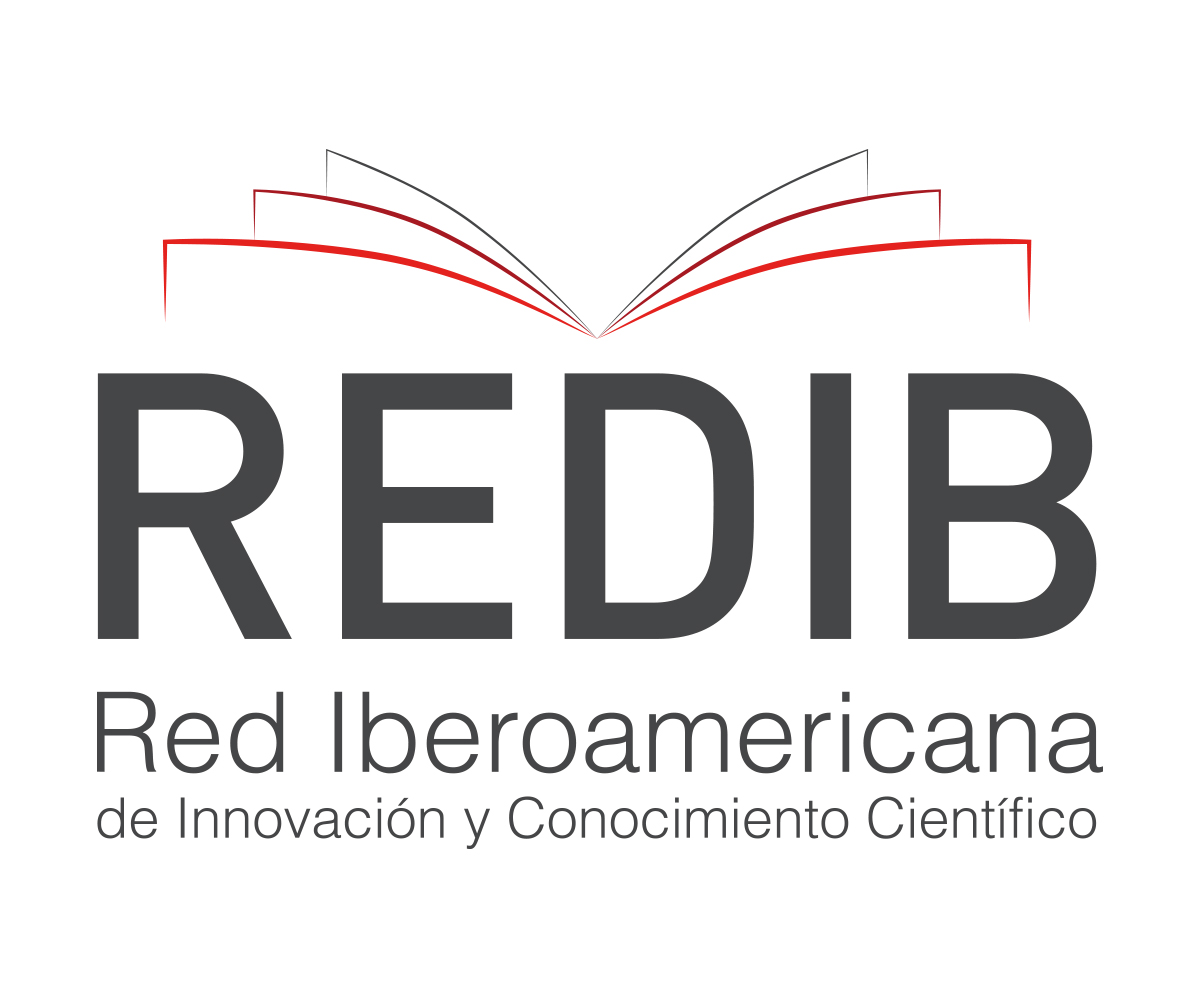Ablación de arritmias cardiacas empleando un sistema de mapeo electroanatómico tridimensional en el Instituto Nacional Cardiovascular - INCOR
DOI:
https://doi.org/10.47487/apcyccv.v2i3.147Palabras clave:
Arritmia cardiaca, Ablación con cateter, PerúResumen
Objetivo. Describir la experiencia inicial en ablación de arritmias cardiacas empleando mapeo 3D en el Instituto Nacional Cardiovascular INCOR (Lima-Perú). Materiales y métodos. Estudio descriptivo, retrospectivo, donde se recolectaron datos de historias clínicas de todos los pacientes en los cuales se realizó ablación empleando mapeo 3D, desde julio de 2017 a diciembre de 2019. Este procedimiento se realizó a pacientes sintomáticos y refractarios a terapia antiarrítmica. Resultados. Se recolectaron datos de 123 pacientes (mediana de edad: 46 años, 64,2% varones), con una mediana del tiempo de enfermedad de 6 años. Entre las arritmias tratadas 19% tuvieron fibrilación auricular; 17,5% taquicardia auricular; 17,5% arritmias ventriculares idiopáticas; 16,6% síndrome de Wolf Parkinson White/taquicardia por reentrada auriculoventricular; 11,1% arritmias ventriculares del sistema de conducción His-Purkinje; 9,5% taquicardia ventricular asociada con cicatriz; 6,4% flutter atrial y 2,4% taquicardia intranodal. La mediana del tiempo de fluoroscopía fue de 26 min. La ablación tuvo éxito agudo en el 95,9% de los casos; las complicaciones agudas se observaron en 4,8%, y la sobrevida libre de recurrencias durante el primer año de seguimiento fue de 74%. Conclusiones. Nuestra experiencia en ablación de arritmias cardiacas empleando mapeo 3D presentó una alta frecuencia de ablación exitosa aguda y baja frecuencia de complicaciones, así como una sobrevida libre de recurrencias del 74%, estimada al año de seguimiento.
Descargas
Referencias
Scheinman MM, Morady F, Hess DS, Gonzales R. Catheter-induced ablation of the atrioventricular junction to control refractory supraventricular arrhythmias. JAMA. 1982;248(7):851-5.
Gallagher JJ, Svenson RH, Kasell JH, German LD, Bardy GH, Broughton A, et al. Catheter technique for closed-chest ablation of the atrioventricular conduction system. N Engl J Med. 1982;306(4):194-200. doi: 10.1056/NEJM198201283060402.
Huang SK, Bharati S, Graham AR, Lev M, Marcus FI, Odell RC. Closed chest catheter desiccation of the atrioventricular junction using radiofrequency energy--a new method of catheter ablation. J Am Coll Cardiol. 1987 ;9(2):349-58.
Huang SK. Radio-frequency catheter ablation of cardiac arrhythmias: appraisal of an evolving therapeutic modality. Am Heart J. 1989 Dec;118(6):1317-23.
Friedman PA. Novel mapping techniques for cardiac electrophysiology. Heart. 2002 Jun;87(6):575-82. doi: 10.1136/heart.87.6.575.
Duru F. CARTO three-dimensional non-fluoroscopic electroanatomic mapping for catheter ablation of arrhythmias: a useful tool or an expensive toy for the electrophysiologist? Anadolu Kardiyol Derg. 2002;2(4):330-7.
Kim YH, Chen SA, Ernst S, Guzman CE, Han S, Kalarus Z, et al. 2019 APHRS expert consensus statement on three-dimensional mapping systems for tachycardia developed in collaboration with HRS, EHRA, and LAHRS. J Arrhythm. 2020;36(2):215-70. doi: 10.1002/joa3.12308.
Gepstein L, Hayam G, Ben-Haim SA. A novel method for nonfluoroscopic catheter-based electroanatomical mapping of the heart. In vitro and in vivo accuracy results. Circulation. 1997;95(6):1611-22. doi: 10.1161/01.cir.95.6.1611.
Asad ZUA, Yousif A, Khan MS, Al-Khatib SM, Stavrakis S. Catheter Ablation Versus Medical Therapy for Atrial Fibrillation: A Systematic Review and Meta-Analysis of Randomized Controlled Trials. Circ Arrhythm Electrophysiol. 2019;12(9):e007414. doi: 10.1161/CIRCEP.119.007414.
Keegan R, Aguinaga L, Fenelon G, Uribe W, Rodriguez G, Scanavacca M, et al. The first Latin American Catheter Ablation Registry. Europace. 2015;17(5):794-800. doi: 10.1093/europace/euu322.
Pappone C, Rosanio S, Oreto G, Tocchi M, Gugliota F, Vicedomini G, et al. Circumferential radiofrequency ablation of pulmonary vein ostia: A new anatomic approach for curing atrial fibrillation. Circulation. 2000;102(21):2619-28. doi: 10.1161/01.cir.102.21.2619.
Peyrol M, Sbragia P. Typical Atrial Flutter - When Do You Say You Have Got It. J Atr Fibrillation. 2012 Oct 6;5(3):712. doi: 10.1371/jafib.712.
Zhong L, Lee YH, Huang XM, Asirvatham S, Shen W, Friedman P, et al. Relative efficacy of catheter ablation vs antiarrhythmic drugs in treating premature ventricular contractions: a single-center retrospective study. Heart Rhythm. 2014 Feb;11(2):187-93. doi: 10.1016/j.hrthm.2013.10.033.
Di Biase L, Santangeli P, Burkhardt DJ, Bai R, Mohanty P, Carbucicchio C, et al. Endo-epicardial homogenization of the scar versus limited substrate ablation for the treatment of electrical storms in patients with ischemic cardiomyopathy. J Am Coll Cardiol. 2012 Jul 10;60(2):132-41. doi: 10.1016/j.jacc.2012.03.044.
Gulletta S, Tsiachris D, Della Bella P. Catheter ablation of an anteroseptal accessory pathway guided by contact force monitoring technology and precise electroanatomical mapping. Europace. 2014 Jun;16(6):825. doi: 10.1093/europace/eut254.
Katritsis DG, Josephson ME. Classification, Electrophysiological Features and Therapy of Atrioventricular Nodal Reentrant Tachycardia. Arrhythm Electrophysiol Rev. 2016;5(2):130-5. doi:10.15420/AER.2016.18.2.
Aksu T, Yalin K, Guler TE, Bozyel S, Heeger C. Tilz R. Acute Procedural Complications of Cryoballoon Ablation: A Comprehensive Review. J Atr Fibrillation. 2019;12(3):2208. Published 2019 Oct 31. doi:10.4022/jafib.2208.
Bohnen M, Stevenson WG, Tedrow UB, Michaud G, John R, Epstein L, et al. Incidence and predictors of major complications from contemporary catheter ablation to treat cardiac arrhythmias. Heart Rhythm. 2011 Nov;8(11):1661-6. doi: 10.1016/j.hrthm.2011.05.017.
Sosa E, Scanavacca M, D’Avila A, Piccioni J, Sanchez O, Velarde JL, et al. Endocardial and epicardial ablation guided by nonsurgical transthoracic epicardial mapping to treat recurrent ventricular tachycardia. J Cardiovasc Electrophysiol.1998;9:229–39. doi: 10.1111/j.1540-8167.1998.tb00907.x.
Gurevitz OT, Glikson M, Asirvatham S, Kester T, Grice S, Munger T, et al. Use of advanced mapping systems to guide ablation in complex cases: experience with noncontact mapping and electroanatomic mapping systems. Pacing Clin Electrophysiol. 2005; 28: 316– 23. doi:10.1111/j.1540-8159.2005.09477.x.
Soto-Becerra R, Zafra-Tanaka JH, Goicochea-Lugo S, Alarcon-Ruiz C, Pacheco-Barrios K, Taype-Rondan A, et al. Guía de práctica clínica para el manejo de pacientes con fibrilación auricular en el Seguro Social del Perú (EsSalud). An Fac Med.2019;80 (2):250-63.
Holmqvist F, Kesek M, Englund A, Blomstrom-Lundqvist C, Karlsson L, Kenneback G, et al. A decade of catheter ablation of cardiac arrhythmias in Sweden: ablation practices and outcomes. Eur Heart J. 2019 Mar 7;40(10):820-30. doi: 10.1093/eurheartj/ehy709.
Ibáñez Criado JL, Quesada A, Cózar R. Spanish Catheter Ablation Registry. 18th Official Report of the Spanish Society of Cardiology Working Group on Electrophysiology and Arrhythmias. Rev Esp Cardiol (Engl Ed). 2019 Dec;72(12):1031-42. English, Spanish. doi: 10.1016/j.rec.2019.08.005.
Wilber DJ, Pappone C, Neuzil P, De Paola A, Marchlinski F, Natale A, et al. Comparison of antiarrhythmic drug therapy and radiofrequency catheter ablation in patients with paroxysmal atrial fibrillation: a randomized controlled trial. JAMA. 2010 Jan 27;303(4):333-40. doi: 10.1001/jama.2009.2029.
Pappone C, Augello G, Sala S, Gugliotta F, Vicedomini G, Gulleta S, et al. A randomized trial of circumferential pulmonary vein ablation versus antiarrhythmic drug therapy in paroxysmal atrial fibrillation: the APAF Study. J Am Coll Cardiol. 2006 Dec 5;48(11):2340-7. doi: 10.1016/j.jacc.2006.08.037.
Oral H, Pappone C, Chugh A, Good E, Bogun F, Pelosi Jr F, et al. Circumferential pulmonary-vein ablation for chronic atrial fibrillation. N Engl J Med. 2006 Mar 2;354(9):934-41. doi: 10.1056/NEJMoa050955.
Mont L, Bisbal F, Hernández-Madrid A, Pérez-Castellano N, Viñolas X, Arenal A, et al. Catheter ablation vs. antiarrhythmic drug treatment of persistent atrial fibrillation: a multicentre, randomized, controlled trial (SARA study). Eur Heart J. 2014 Feb;35(8):501-7. doi: 10.1093/eurheartj/eht457.
Cappato R, Calkins H, Chen SA, Davies W, Iesaka Y, Kalman J, et al. Updated worldwide survey on the methods, efficacy, and safety of catheter ablation for human atrial fibrillation. Circ Arrhythm Electrophysiol. 2010 Feb;3(1):32-8. doi: 10.1161/CIRCEP.109.859116.
Tondo C, Carbucicchio C, Dello Russo A, majocchi B, Zucchetti M, Pizzamiglio F, et al. Idiopathic Ventricular Tachycardia:Transcatheter Ablation or Antiarrhythmic Drugs? J Atr Fibrillation. 2015;7(5):1164. doi:10.4022/jafib.1164.
Callans DJ. Catheter ablation of idiopathic ventricular tachycardia arising from the aortic root. J Cardiovasc Electrophysiol. 2009 Aug;20(8):969-72. doi: 10.1111/j.1540-8167.2009.01461.x.
Liu Y, Fang Z, Yang B, Kojodjojo P, Chen H, Ju W, et al. Catheter Ablation of Fascicular Ventricular Tachycardia: Long-Term Clinical Outcomes and Mechanisms of Recurrence. Circ Arrhythm Electrophysiol. 2015;8(6):1443–51. doi:10.1161/CIRCEP.115.003080.
Stevenson WG, Wilber DJ, Natale A, Jackman W, Marchlinski F, Talbert T, et al. Irrigated radiofrequency catheter ablation guided by electroanatomic mapping for recurrent ventricular tachycardia after myocardial infarction: the multicenter thermocool ventricular tachycardia ablation trial. Circulation. 2008 Dec 16;118(25):2773-82. doi: 10.1161/CIRCULATIONAHA.108.788604.
Katja Zeppenfeld. Ventricular Tachycardia Ablation in Nonischemic Cardiomyopathy. JACC: Clinical Electrophysiology 2018; 4(9). doi: 10.1016/j.jacep.2018.06.014.
Piers S.R., Leong D.P., Van Huls van Taxis C.F, Tayyebi M, Trines S, Pijnappels D, et al. Outcome of ventricular tachycardia ablation in patients with nonischemic cardiomyopathy: the impact of noninducibility. Circ Arrhythm Electrophysiol 2013; 6:513–21. DOI: 10.1161/CIRCEP.113.000089.
Muser D, Santangeli P, Castro SA, Pathak R, Liang J, Hayashi T, et al. Long-Term Outcome After Catheter Ablation of Ventricular Tachycardia in Patients With Nonischemic Dilated Cardiomyopathy. Circ Arrhythm Electrophysiol. 2016 Oct;9(10):e004328. doi: 10.1161/CIRCEP.116.004328.


















